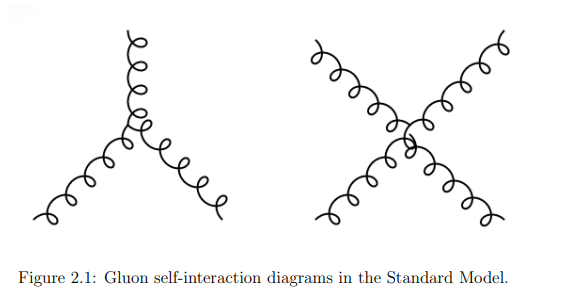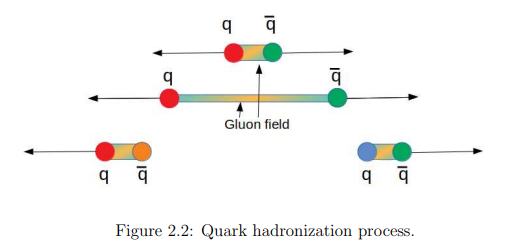PX156 - H2 - the strong force
-
boson: gluons (
) - rest mass:
- technically infinite range
- but carry colour charge themselves
- rest mass:
-
conserves all quantum numbers
-
a gluon carries a colour, and an anti-colour
- eg:
- eg:
-
needed to conserve colour at vertices
- eg:
- eg:
-
there are 8 gluons in the strong force
-
there is one gluon that cannot be seen: a colourless gluon
- eg:
cannot exist
- eg:
-
so, some decays cannot happen
- eg:
no! as is colourless
- eg:
-
gluons can interact with other gluons
-
this is the defining difference with the EM interaction

-
large distances: constant, very strong, restoring force with the form:
-
at a small distance,
-
-
as
-
small distances (within nucleons): acts like the EM force, but is very weak
-
small distances between quarks: coulomb force dominates
-
eg:
- within a nucleus,
force - long distances:
constant attractive force
- within a nucleus,
-
this drives the behaviour of the strong force at large distances
-
acts like a rubber band
-
two distinct types of behaviours at different distance scales
-
small distances: ends can move independently and freely
-
large distances: energy stored as it 'stretches'
-
eventually energy stored is enough to break the bond and the band snaps
hadronization & the principle of confinement
-
quarks can never be separated from nuclei to get a lone quark
-
as quarks separate, more energy needs to be donated and this energy is stored in the colour field between the quarks
-
at some point, the energy density in the field is greater than the mass of two quarks
-
at this point, the colour tube snaps and creates two new quarks
-
this process is called hadronization
-
the fact that quarks are locked in hadrons is called the 'principle of confinement'

-
in experiments, this gives rise to jets of hadrons that are clustered around the direction of one of the initial quarks
